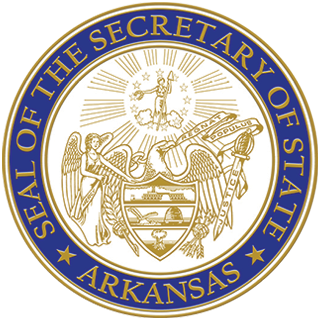State Governors 1901-1917
State Governors 1901-1917
Jefferson Davis
Born: May 6, 1862, near Rocky Comfort, Arkansas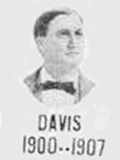
Died: January 3, 1913, at Little Rock, Arkansas
Buried: Mount Holly Cemetery, Little Rock
Served: 1901-1907
Jefferson Davis, born in Sevier County and raised in Dover and Russellville, attended the University of Arkansas and studied law at Vanderbilt University and, ultimately, Cumberland University. He served as prosecuting attorney of the Fifth Judicial District of Arkansas from 1892 to 1896, and he was elected attorney general in 1898, serving until 1900. Davis was elected Arkansas's 20th governor on September 3, 1900. He was re-elected in 1902, and again in 1904, becoming the first governor to serve more than two consecutive terms. During his administration laws were enacted for segregation on streetcars, a reform school was established and the Arkansas History Commission was created. Also during his tenure, public executions were prohibited, and salaries were defined for members of the state legislature. Davis was known for his deep opposition to convict leasing, his attempts to halt construction of a new capitol building, his command of populist rhetoric and his ability to exploit racial and class tensions in his own behalf. Davis was elected to the U.S. Senate in 1906, and served there until his death in early January 1913.
John Sebastian Little
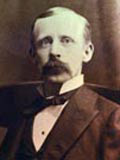 Born: March 15, 1851, in Sebastian County, Arkansas
Born: March 15, 1851, in Sebastian County, Arkansas
Died: October 29, 1916, at Little Rock, Arkansas
Buried: City Cemetery, Greenwood, Arkansas
Served: 1907
Arkansas's 21st governor was born in Jenny Lind, Sebastian County, Arkansas and attended Cane Hill College in Washington County for one term, taught school, studied law, and was admitted to the Arkansas bar in 1873. Little entered politics in 1876 when he campaigned for and won election as prosecuting attorney of the Twelfth Judicial Circuit, serving until 1884. In that year he was elected to the Arkansas House of Representatives in 1884, and two years later was elected to serve on the bench of the Twelfth Judicial Circuit, a position he held until 1890. In 1894, he was elected to the U.S. House of Representatives and served six terms there. In 1906, Little ran for governor. Endorsed by outgoing governor Davis and his former colleagues in the House of Representatives, Little won handily at both primary and general elections. In his inaugural address, Little asked the Arkansas legislature for a broad program of action including trusts regulation, free school textbooks, election reforms, the suppression of vice and gambling, as well as comprehensive programs of levee-building and road improvement, plus a final end to convict leasing. Two days later, however, Little suffered a near-total mental and physical collapse. During his extended recuperation at his home in Greenwood and on the Texas gulf coast, Senate president John I. Moore initially served as acting governor; after the adjournment of the Assembly May 1907 Moore was replaced in this capacity by incoming Senate President pro tempore X.O. Pindall. Governor Little never recovered his health, although he spent time at hospitals in Texas and Missouri. He died in 1916 in the Arkansas State Hospital for Nervous Diseases.
George Washington Donaghey
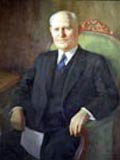 Born: July 1 1856, at Oakland, Louisiana
Born: July 1 1856, at Oakland, Louisiana
Died: December 15, 1937, at Little Rock, Arkansas
Buried: Roselawn Memorial Park, Little Rock
Served: 1909-1913
Arkansas's 22nd governor was born in northern Louisiana but was brought to Arkansas at an early age. He briefly attended the University of Arkansas, taught school, was a carpenter, and studied architecture and structural engineering, becoming proficient in both. By the mid-1890s, Donaghey had become a successful building and railroad contractor. In 1899, Donaghey was named to the newly-formed Arkansas Capitol Commission. Construction began under Donaghey's direction that summer; he was removed from the commission in 1901 but in 1903 served briefly as foreman for the project. In 1908 Donaghey successfully ran for governor on a progressive platform which included his promise to complete the Capitol, unfinished due to financial and political obstacles; he was re-elected in 1910. As governor, Donaghey strove to improve public health, education, roads, and railways and in 1911 presided over the inaugural legislative session to be held in the new state capitol. The Booneville Tuberculosis Sanitarium was created, as well as four agricultural high schools that later developed into Arkansas Tech, Arkansas State, Southern State, and the University of Arkansas at Monticello. In 1910 Donaghey campaigned alongside William Jennings Bryan throughout the state urging voters to approve Amendment 10, an authorizing adoption of the initiative and referendum. His greatest achievement was the termination of the convict-lease system; Donaghey accomplished this in December 1912 by pardoning 360 inmates, nearly half of the penitentiary population, thus ruining the value of the leases. After leaving office Donaghey returned to construction and property management but also served on public and charitable commissions for more than two decades, leaving at his death a great legacy of public service.
Joseph Taylor Robinson
Born: August 26 1872, near Lonoke, Arkansas
Died: July 14 1937, at Washington, D.C.
Buried: Roselawn Memorial Park, Little Rock
Served: 1913
Joseph T. Robinson attended the University of Arkansas and earned a law degree from the University of Virginia in 1895. Robinson elected to the Arkansas House in 1894; he served one term, and then returned to Lonoke to practice law. In 1902 Robinson won election to the U.S. Congress from Arkansas's Sixth Congressional District, and served until 1913. Nominated and winning election for governor in 1912, Robinson resigned his seat in Congress on January 14, 1913. He was inaugurated governor on January 16, 1913. On January 28, 1913, Robinson was elected to the U.S. Senate and continued to hold the governor's office until March 8, 1913, when he officially resigned. During his short term as governor, appropriations were granted to complete the state capitol, a state banking department was created, and a bureau of labor statistics was established. Also, the state flag was adopted, and a highway commission was created within the state land department. Robinson had a lengthy and distinguished career in the U.S. Senate. He served there until 1937, becoming Democratic majority leader in 1932, and was an early and steadfast ally of President Franklin Roosevelt. Robinson died in the midst of the controversy over Roosevelt's "court-packing" plan; paying tribute to Robinson, Roosevelt called him "a pillar of strength . . . . [he] has fallen with face to the battle."
George Washington Hays
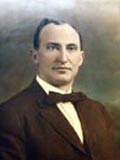 Born: September 23, 1863, at Camden, Arkansas
Born: September 23, 1863, at Camden, Arkansas
Died: September 15, 1927, at Little Rock, Arkansas
Buried: Camden, Arkansas
Served: 1913-1917
George Washington Hays studied law at the Washington and Lee University in Lexington, Virginia; in 1894 Hays set up his own law practice in Camden. He served as probate and county judge for Ouachita County from 1900 to 1905, and served on the bench of the 13th Judicial Circuit from 1906 to 1913. Due to the resignation of Governor Joseph T. Robinson, a special election was held and on July 23, 1913, Hays became Governor of Arkansas. In office, Hays showed little enthusiasm for reform and was accused by progressives of being susceptible to pressure from various interest groups. Nevertheless, his personal popularity and political acumen won him a second term in 1914. During his tenure, the Alexander Road Improvement Act was passed, a child labor law was enacted (though poorly enforced), and statewide prohibition became the law, after much vacillation on Hays's part. Hays vetoed a bill which would have legalized pari-mutuel betting at Hot Springs, although he initially signed the bill into law. In addition, during Hays's tenure a full-time commission for governance of the state's charitable institutions was created, and construction on the new state capitol was declared completed. After leaving office, Hays returned to his law practice, publishing several articles in national periodicals, including justifications for the death penalty and explaining the reasons behind lynching of "low-grade negroes." Shortly before his death in 1927, Hays supported the presidential candidacy of New York Democrat Alfred Smith in several articles, predicting that Southern states would support the Democratic nominee in order to protect their "social and racial interests."




